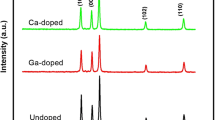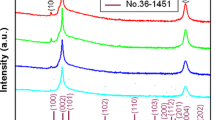Abstract
An extensive study of the effect of various technological factors on the electrical properties of ZnO thin films obtained by DC magnetron sputtering of ZnO:Ga:Cl ceramic targets on glass substrates has been carried out. The effect of deposition temperature, film thickness, growth rate, background pressure, working gas pressure, preliminary slow-growing and undoped layers, stoichiometric deviation, and Ga and Cl concentrations has been studied. Changes in the growth rate, transparency in the ultraviolet and visible spectral ranges, morphology, crystallinity, and crystallite size have also been analyzed. It has been shown that the effect of co-doping with Cl is most significant at the lowest temperatures, which can decrease the resistivity of the films by 2 times at a deposition temperature of 100 °C. Zinc oxide thin films with a resistivity of 2.5 × 10− 4 Ω⋅cm and a figure of merit of 31 kΩ− 1 have been successfully obtained. A theoretical model taking into account various types of mobile gallium chlorides has been proposed to elucidate the advantage of co-doping with Cl.








Similar content being viewed by others
References
K. Ellmer, A. Klein, B. Rech. Transparent conductive Zinc oxide (Springer-Verlag, Berlin Heidelberg, 2008)
Ü Özgür, Ya.I. Alivov, C. Liu, A. Teke, M.A. Reshchikov, S. Doğan, V. Avrutin, S.-J. Cho, H. Morkoç. A comprehensive review of ZnO materials and devices. J. Appl. Phys. 98, 041301 (2005)
M. Norouzi, M. Kolahdouz, P. Ebrahimi, M. Ganjian, R. Soleimanzadeh, K. Narimani, H. Radamson. Thermoelectric energy harvesting using array of vertically aligned Al-doped ZnO nanorods. Thin Solid Films 619, 41 (2016)
M. Lalanne, J.M. Soon, A. Barnabe, L. Presmanes, I. Pasquet, Ph. Tailhades. Preparation and characterization of the defect–conductivity relationship of Ga-doped ZnO thin films deposited by nonreactive radio-frequency–magnetron sputtering. J. Mater. Res. 25, 2407 (2010)
A. Kh. A.K. Abduev, A. Akhmedov, A.A. Sh. Asvarov, S.N. Abdullaev, Sulyanov, Effect of growth temperature on properties of transparent conducting gallium-doped ZnO films. Semiconductors 44, 32 (2010)
E. Fortunato, L. Raniero, L. Silva, A. Gonçalves, A. Pimentel, P. Barquinha, H. Águas, L. Pereira, G. Gonçalves, I. Ferreira, E. Elangovan, R. Martins, Highly stable transparent and conducting gallium-doped zinc oxide thin films for photovoltaic applications. Solar Energy Materials & Solar Cells 92, 1605 (2008)
A. Kh. A.K. Abduev, A. Akhmedov, Sh, Asvarov. Transparent conducting ZnO-based thin films deposited by magnetron sputtering of a ZnO:Ga-C composite targets. Technical physics letters 40, 618 (2014)
A. Kh. A. Abduev, A.K. Sh. Asvarov, R.M. Akhmedov, V.V. Emirov, Belyaev, UV-assisted growth of transparent conducting layers based on zinc oxide. Technical physics letters 43, 1016 (2017)
W. Jia Liu, D. Zhang, Q. Song, L. Ma, H. Zhang, X. Zhang, H. Ma Song, Comparative study of the sintering process and thin film sputtering of AZO, GZO and AGZO ceramics targets. Ceram. Int. 40, 12905 (2014)
C.A. Gupta, S. Mangal, U.P. Singh, Impact of rapid thermal annealing on structural, optical and electrical properties of DC sputtered doped and co-doped ZnO thin film. Appl. Surf. Sci. 288, 411 (2014)
M. Miyazaki, K. Sato, A. Mitsui, H. Nishimura. Properties of Ga-doped ZnO films. J. Non-Cryst. Solids 218, 323 (1997)
J. Nomoto, H. Makino, T. Nakajima, T. Tsuchiya, T. Yamamoto, Improvement of the properties of direct-current magnetron-sputtered Al-doped ZnO polycrystalline films containing retained Ar atoms using 10-nm-thick buffer layers. ACS Omega 4, 14526 (2019)
F.-H. Wang, C.-F. Yang, J.-C. Liou, I.-C. Chen, Effects of hydrogen on the optical and electrical characteristics of the sputter-deposited Al2O3-doped ZnO thin films. J. Nanomater. 2014: 857614 (2014)
H.S. Yoon, K.S. Lee, T.S. Lee, B. Cheong, D.K. Choi, D.H. Kim, W.M. Kim, Properties of fluorine doped ZnO thin films deposited by magnetron sputtering. Sol. Energy Mater. Sol. Cells 92, 1366 (2008)
F.-H. Wang, C.-F. Yang, Y.-H. Lee, Deposition of F-doped ZnO transparent thin films using ZnF2-doped ZnO target under different sputtering substrate temperatures. Nanoscale Res. Lett. 9, 97 (2014)
E. Chikoidze, M. Nolan, M. Modreanu, V. Sallet, P. Galtier, Effect of chlorine doping on electrical and optical properties of ZnO thin films. Thin Solid Films 516, 8146 (2008)
F.-H. Wang, C.-L. Chang, Effect of substrate temperature on transparent conducting Al and F co-doped ZnO thin films prepared by RF magnetron sputtering. Appl. Surf. Sci. 370, 83 (2016)
F. Tsin, A. Venerosy, J. Vidal, S. Collin, J. Clatot, L. Lombez, M. Paire, S. Borensztajn, C. Broussillou, P.P. Grand, S. Jaime, D. Lincot, J. Rousset. Electrodeposition of ZnO window layer for an all-atmospheric fabrication process of chalcogenide solar cell. Sci. Rep. 5, 8961 (2015)
A. Jiamprasertboon, S.C. Dixon, S. Sathasivam, M.J. Powell, Y. Lu, T. Siritanon, C. J. Carmalt. Low-cost one-step fabrication of highly conductive ZnO:Cl transparent thin films with tunable photocatalytic properties via aerosol-assisted chemical vapor deposition. ACS Appl. Electron. Mater. 1, 1408 (2019)
G.V. Colibaba, Sintering highly conductive ZnO:HCl ceramics by means of chemical vapor transport reactions. Ceramics international 45, 15843 (2019)
G.V. Colibaba, ZnO:HCl single crystals: Thermodynamic analysis of CVT system, feature of growth and characterization. Solid State Sci. 56, 1 (2016)
G.V. Colibaba, Halide-hydrogen vapor transport for growth of ZnO single crystals with controllable electrical parameters. Mater. Sci. Semicond. Process. 43, 75 (2016)
G.V. Colibaba, Halide-oxide carbon vapor transport of ZnO: Novel approach for unseeded growth of single crystals with controllable growth direction. J. Phys. Chem. Solids 116, 58 (2018)
G.V. Colibaba, Halide-carbon vapor transport of ZnO and its application perspectives for doping with multivalent metals. J. Solid State Chem. 266, 166 (2018)
G.V. Colibaba, D. Rusnac, V. Fedorov, P. Petrenko, E.V. Monaico, Low-temperature sintering of highly conductive ZnO:Ga:Cl ceramics by means of chemical vapor transport. J. Eur. Ceram. Soc. 41, 443 (2021)
G.V. Colibaba, A. Avdonin, I. Shtepliuk, M. Caraman, J. Domagała, I. Inculet. Effects of impurity band in heavily doped ZnO:HCl. Physica B: Condenced matter 553, 174 (2019)
F.-H. Wang, C.-F. Yang, M.-C. Liu, Using flexible polyimide as a substrate to deposit ZnO: Ga thin films and fabricate p-i-n α-Si: H thin-film solar cells. Int. J. Photoener. 2013: 263213 (2013)
T.S. Moss, The interpretation of the properties of indium antimonide. Proc. Phys. Soc. B 67, 775 (1954)
G. Haacke, New figure of merit for transparent conductors. J. Appl. Phys. 47, 4086 (1976)
N. Benramdane, W.A. Murad, R.H. Misho, M. Ziane, Z. Kebbab, A chemical method for the preparation of thin films of CdO and ZnO. Mater. Chem. Phys. 48, 119 (1997)
B.D. Cullity. Elements of X-ray Diffraction (Addison-Wesley Publishing Company Inc., Phillippines, 1978)
A. Kuroyanagi, Crystallographic characteristics and electrical properties of Al-doped ZnO thin films prepared by ionized deposition. J. Appl. Phys. 66, 5492 (1989)
S.-U. Park, J.-H. Koh. Low temperature rf-sputtered In and Al co-doped ZnO thin films deposited on flexible PET substrate. Ceram. Int. 40, 10021 (2014)
S.D. Ponja, S. Sathasivam, I.P. Parkin, C. J. Carmalt. Highly conductive and transparent gallium doped zinc oxide thin films via chemical vapor deposition. Sci. Rep. 10, 638 (2020)
J.-H. Kim, T.-Y. Seong, K.-J. Ahn, K.-B. Chung, H.-J. Seok, H.-J. Seo, H.-K. Kim, The effects of film thickness on the electrical, optical, and structural properties of cylindrical, rotating, magnetron-sputtered ITO films. Appl. Surf. Sci. 440, 1211 (2018)
D. Gogova, A. Suwardi, Y.A. Kuznetsova, A.F. Zatsepin, L.A. Mochalov, A. Nezhdanov, B. Szyszka, Lanthanum-doped barium stannate - a new type of critical raw materials-free transparent conducting oxide. Int. J. Adv. Appl. Phys. Res. 4, 1 (2017)
R.T. Tucker, N.A. Beckers, M.D. Fleischauer, M. J. Brett. Electron beam deposited Nb-doped TiO2 toward nanostructured transparent conductive thin films. Thin Solid Films 525, 28 (2012)
F. Daniels, R.A. Alberty, Physical Chemistry (John Willey & Sons, New York – London, 1961)
V.P. Glushko et al., Thermodynamic properties of individual substances (Nauka Publishing House, Moscow, 1978)
G.V. Colibaba, ZnO doping efficiency by multivalent metals in complex CVT reactions. Solid State Sciences 97: 105944 (2019)
Acknowledgements
The authors wish to thank Dr. N. Kostrikova for XRD measurements.
Funding
This work was supported by the Ministry of Education, Culture, and Research of Moldova under project No. 20.80009.5007.16 (Photosensitizers for applications in pharmaceutical medicine and photovoltaics)
Author information
Authors and Affiliations
Corresponding author
Ethics declarations
Conflict of interest
The authors declare that they have no known competing financial interests or personal relationships that could have appeared to influence the work reported in this paper.
Additional information
Publisher’s Note
Springer Nature remains neutral with regard to jurisdictional claims in published maps and institutional affiliations.
Rights and permissions
About this article
Cite this article
Colibaba, G.V., Rusnac, D., Fedorov, V. et al. Effect of chlorine on the conductivity of ZnO:Ga thin films. J Mater Sci: Mater Electron 32, 18291–18303 (2021). https://doi.org/10.1007/s10854-021-06371-x
Received:
Accepted:
Published:
Issue Date:
DOI: https://doi.org/10.1007/s10854-021-06371-x




